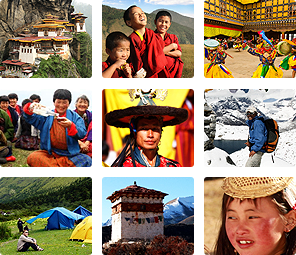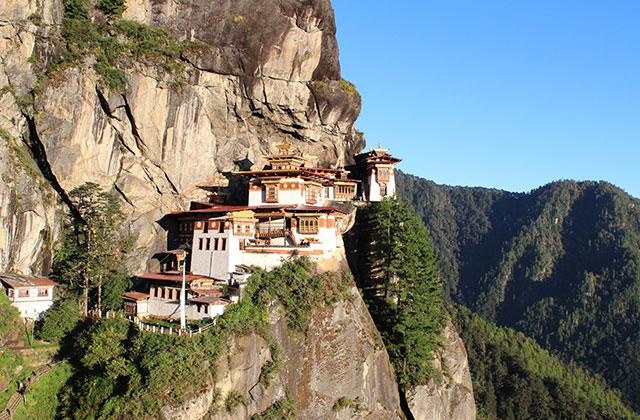
Bhutan is popularly known to the people as Drukyul – the land of the Thunder Dragon. The Drukpa Kagyu sect of Buddhism has been the state religion since the 13th century. Since then the people are called Drukpas (the followers of Drukpa Kagyu) and the country is known as Drukyul (The land of the Drukpa and the Land of the Thunder Dragon). Bhutan is believed to have come from the Sanskrit word “Bhut-Uttan” which means “High Land”.
Bhutan is situated along the southern slopes of the great Himalayan range. The country is landlocked and mountainous wedged between two giant countries, China to the north and India to the south. It is one of the smallest countries in the world. The country is about 300-km wide and 150-km long which is the size of Switzerland as the crow flies. But it remains the most mysterious country in South Asia and holds many surprises.
More than 70 percent of the country is under forest cover and is recognized as an area with a high diversity of flora and fauna. The country is one of the top ten biodiversity hotspots in the world and is known as the East Himalayan hotspot. A wide range of animals could be found frequenting the jungles and has a great variety of bird species. It has more than 200 species of mammals and 700 species of birds. These include the rare and endangered such as the royal Bengal tiger and White-bellied heron. Besides, Bhutan is also home to some of the highest virgin mountain peaks in the world.
The country is an ancient land where the modern development process such as the construction of roads, schools, and hospitals began in the 1960s. The rugged landscape and pristine environment make Bhutan a welcoming and natural tourist destination. It is worth visiting the kingdom of the Himalayas. Bhutan opened its door for tourists in 1974 to raise revenue and promote the unique culture and traditions.
Bhutan follows a policy of “high-value low impact tourism”. This means that the industry must be environmentally friendly, and socially and culturally acceptable. The government strongly adheres to this policy. This policy helped to promote Bhutan as an exclusive destination. It serves the purpose of creating an image of exclusivity and high yield for Bhutan. Today, Bhutan is one of the most visited countries in the world.
Most Bhutanese belong to the western and eastern parts of the country. There are 19 spoken local dialects, including a national language – Dzongkha. Besides Dzongkha, the three other dominant languages include Tshanglakha or Sharchokpa – spoken in eastern Bhutan, Lhotshamkha or Nepali – spoken in the southern region and Bumthangkha – spoken in central Bhutan. But English is widely spoken as the medium of communication. Most specifically the youngsters are more inclined to English.
Bhutan is an agrarian economy with 79 percent of the population engaged in agriculture and livestock farming. Agriculture is the mainstay of the people of Bhutan. Rice and maize are the major cereal crops grown in the village and rice is, by far, the most important and preferred food crop of the farmers. The crop holds a huge potential because the villages are connected by a farm road. The farmers also grow potatoes and vegetables, among others.
The latest census in the country carried out in 2017 showed about 500,000 friendly people living deeply with spiritual beliefs in the country. The population density is 18 people per square kilometer, which is one of the lowest population densities in the world. It is a land of legends, Yeti folktales, Buddhist spirit, peace, and tranquillity. And remains a mystery to most people around the world.
The development activities are still taking place after a few decades of planned development to modernize the economy and move away from its geographic isolation. The people are embracing modernity but protective of their age-old traditions, values, and identities. Thimphu, the capital of Bhutan has transformed from a beautiful little town into a modern town. This urban development began at a slow pace in 1961, with the launch of Bhutan’s first Five-Year Plan.

The early history of Bhutan is steeped in mythology and remains obscure. Many of the existing records were destroyed in fire disasters and thus plagued the past of the country.
The most recent history is generally considered, to begin with, the advent of Buddhism, following the visit of the great Indian tantric master, Guru Rinpochhe (Padmasambhava), in the 17th century. He went to many great teachers of his time and mastered all the highest religious teachings. He also mediated in various places and started preaching. According to the legend, Guru Rinpochhe visited Bhutan at the beginning of the 8th century and propagated Buddhism in the country.
In the 12th century, a few hundred years after Guru Rinpochhe had visited Bhutan, Phajo Drukgom Zhigpo (1184–1251) came to Bhutan from Ralung in Tibet. He established the Drukpa Kagyu School which is the dominant Buddhist sect in the country. Phajo Drukgom Zhigpo was a founder of Drukpa Kagyu School.
Between the 11th and 16th centuries, Terton Pema Lingpa (Treasure revealers) discovered sacred texts. These texts were believed to be buried by Guru Rinpochhe. He buried to be discovered at a predestined time in the future for the propagation of Buddhism.
In 1475, Terton Pema Lingpa unearthed a terma (treasure) from Membartsho (burning lake) in Bumthang. He also discovered treasures from many other places in Bhutan and far beyond Tibet. He composed many religious texts and sacred dances, created artworks and build monasteries. Pema Lingpa’s descendants spread to all parts and formed the families of the country. Bhutan’s Royal Family descends from his lineage and he is a key figure in Bhutanese history.
In 1616, Zhabdrung Ngawang Namgyel (1594–1651), the founding father of Bhutan, left Ralung for Bhutan. One of the most important achievements of Zhabdrung was the building of the Dzongs (fortress) across the country. He set up a system of administration which was aimed at making a strong and united country. Besides, he has given Bhutan its political, religious and cultural identity.
After Zhabdrung’s death, the country descended into a period of internal conflict for the next two centuries. This was because the local chieftains fought for supremacy. During this period, the Bhutanese fought several wars with the people of Cooch Behar and British India. The ordinary people found life difficult in these times.
The people of Bhutan have always wanted a strong and powerful leader who could bring all the fighting and rival groups in one control. Towards the end of the 19th century, Trongsa Penlop (governor), Jigme Namgyal (1825–82), emerged as the most powerful chieftain in Bhutan. He proved to be a very able and responsible officer.
Jigme Namgyal took over the reins of Trongsa Penlop in 1853. Braving several conspiracies and feuds, he further consolidated his Trongsa powerhouse. By then the local lords of the west had come to respect Jigme Namgyel. In 1870, he was appointed the Desi and re-established a strong central government.
On 17 December 1907, Jigme Namgyel’s son, Ugyen Wangchuck has unanimously enthroned the first Dragon King. The monk body, government, and the people elected him the first hereditary King of Bhutan. The enthronement of Gongsar Ugyen Wangchuck is a paradigm and marked the dawn of a new era in the country. He proved to be the most powerful leader and all the important decisions were made under his guidance. He also put an end to the Desi system of governance.
At the time when Bhutan was enthroning its first King, the powerful nations of the world were divided into two power. In the absence of a close, reliable and powerful ally, there was every possibility that small nations would be influenced by powerful nations. Bhutan thus signed the Treaty of Punakha with British India in 1910. The treaty reinforced Bhutan’s security and sovereignty. It was proposed by the British to replace the old Treaty of Sinchula. This helped to further strengthen relations between Bhutan and British India.
On 14 March 1927, barely six months after the passing of first King, Crown Prince Jigme Wangchuck was crowned the second Druk Gyalpo. The period in which His Majesty became the King was perhaps the most challenging one. His father bequeathed to him a young and tender Kingdom. He had to shoulder the daunting responsibility of consolidating the Kingdom.
The task of restructuring the administrative mechanism to create a uniform system was immense. The king created an effective mechanism of tax collection besides strengthening the types of taxes collected. He also abolished certain taxes paid in kinds like cloth, fodder, firewood, soot, and butter, among others. He finally achieved Bhutan’s status as a sovereign nation
When Druk Gyalpo Jigme Wangchuck passed away in 1972, Crown Prince Jigme Dorji Wangchuck, succeeded to the throne. His Majesty the King assumed the position of head of the government, the Commander-in-Chief of the Army and the ultimate Court of Appeal. He established the National Assembly and High Court abolished serfdom and reorganized land holdings, among others.
During Druk Gyalpo Jigme Wangchuck’s reign, Bhutan started its plan for modern development in 1960 with technical and financial assistance from India. His Majesty the King opened the kingdom’s doors to the outside world, bringing the country into the international mainstream. It joined the Colombo Plan in 1962 and the Universal Postal Union in 1971.
His Majesty the Great Fourth Jigme Singye Wangchuck succeeded to the Golden Throne in 1972, after His Majesty the third Druk Gyalpo passed away on 21 July. His Majesty was 16 but had already proven his maturity and statesmanship to assume the reins of the government. Bhutan is thus known as the Kingdom ruled by the youngest King in the world.
The King told the world, in the early years of his reign, that Gross National Happiness is more important than Gross Domestic Product. He continued the program of modernization and stressed on economic self-reliance. This tiny Kingdom along with its young King succeeded.
His Majesty the King Jigme Khesar Namgyel Wangchuck was officially throned on 1 November 2008. It was on 9 December, when His Majesty the Great Fourth surprisingly announced his abdication in favour of Crown Prince.
It was the first time in the world that a monarch voluntarily gave up his powers for his commitment to political reforms and his nation. His Majesty thus became the youngest head of state at the age of 27. But he displayed a maturity that the world watched in awe-inspiring curiosity.
Bhutan held its first general elections in March 2008, and the second elections in July 2013. Since then His Majesty has been taking the country into a new era of democracy and economic progress while striving to retain Bhutan’s cultural uniqueness.
Having a nature of respect, His majesty meets village people and visits village homes along the way. He has been visiting the remote pocket of the country, mostly on foot for long hours into the late night. He makes a point of stopping frequently on his travels so that everyone can have the chance to approach him with their troubles. He has been demonstrating kindness to the people and famous as peoples’ king

Bhutanese culture is strongly influenced by Mahayana Buddhism. Religion and culture are interconnected that adds value to the identity of Bhutan. Bhutanese people deeply held religious beliefs such as the law of karma and the cycle of rebirth. It is an integral part of Bhutanese life that every segment of people visit temples and monasteries to offer prayers and butter lamps.
The expressions of Bhutanese culture can be seen in its architecture, textiles, art and craft, ceremonies and festivals, and languages and lifestyles. These promote the country’s pride by celebrating things that transform an ideal destination for the visitors. Each visitor is sure to find the perfect way to discover.
Bhutan has mainly followed the Tibetan tradition of Buddhist architecture. But it has a distinctive Bhutanese style that has evolved over the centuries. Bhutan’s artistic tradition is best reflected in Zorig Chusum – the 13 traditional arts and crafts, which include calligraphy, painting, sculpture carving, applique, pottery, smithy, and masonry, among others.
The way of dress, eat, talk and behave is quite different from how other countries do. This is because of a unique culture, traditions, and customs that every Bhutanese follows to fit into the Bhutanese society.
The Gho and Kira that people wear is the national dress. It is made from different types of material to suit different climatic and seasonal changes. Bhutanese wear the national dress at schools, government offices, institutions, temples and monasteries and for formal occasions. It is a custom passed down by the ancestors that give a distinct identity.
The Gho is for men. The design of the Gho comes from the robe worn by Buddhist teachers. It is like a flowing robe hiked up to the knee and held at the waist by a woven belt. The sleeves of the Gho were made narrower to suit the manual work the men did earlier times and it still does in the village.
The Kira is for women. It is an ankle-length dress. It consists of fabric in a rectangular piece that is wrapped and folded around the body. It is then held at the waist by a cloth belt. The Kira is worn with an inner jacket “wonju” and outside jacket “tego”.
A set of social customs deals with outward appearance and actions such as the way of dress, eat, greet and behave with others. Likewise, the way of speaking deals on how the children should speak to their parents, the younger to the elder, the junior to the senior, including speaking the truth and usage of good language. It further deals with the way of thinking such as being grateful to others for their help and kindness, respecting the elders, wishing good things for others and thinking good of serving the King, Country, and its People.
Bhutan is in the form of western, central and southern regions. Traditionally, the western region believes that the wealth and property of the family should be passed down to the daughters while the sons are required to make their living. However, the current scenario provides equal properties and land if they wish to demand.
Archery in Bhutan is the national sport. Bhutan declared the national sport in 1971 when it became a member of the United Nations. Since then, the popularity of Bhutanese archery has increased both inside and outside the country. It maintains an Olympic archery team. It is more of a social occasion than a competition. Not limited to this, other traditional sports include Khuru (dart) and Dego (flat round stones similar to the modern Discus). These sports are played during religious and secular public holidays in Bhutan and local festivals.
Rice production in Bhutan plays an important role in food supply and cultivated largely for domestic consumption. The farmers also grow wheat, buckwheat, barley, and maize, among others. Many parts of the country is a fertile land to grow all cereals. The farmers also grow potatoes, chilies, and organic vegetables. Bhutanese people consume a good quantity of dairy products and enormous amounts of chilies. Ema Datshi (chili and cheese) is regarded as the national dish. A few brave tourists try out at least once to get the full flavour of Bhutan.
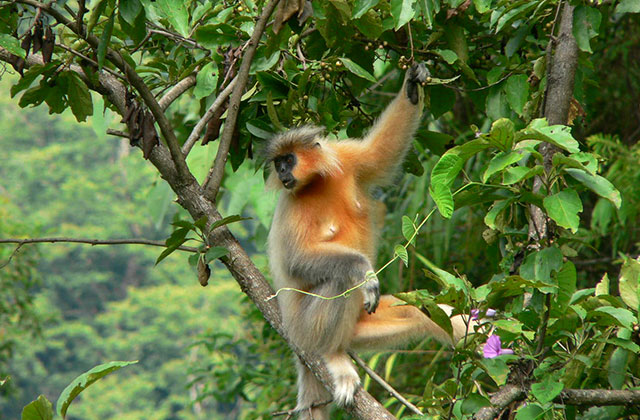
Bhutan is recognized globally as a hotspot for biodiversity. It has been able to preserve its spectacular environment throughout the centuries. The ecological diversity within its small boundaries is amazing. It is home to elephants, rhinoceros, tigers, leopards, mountain goats, bears, birds, blue sheep, and snow leopards.
The Buddhist view of the interdependence between man and nature holds the relation very strong. The need to revere the diversity of life has guided Bhutan to maintain and respect its natural environment. This makes Bhutan one of the best examples of sustainable ecotourism and a natural paradise in the world.
The Constitution of the Kingdom of Bhutan mandates that the country shall maintain 60 percent of forest cover for all times to come. It is also in line with the principles of Gross National Happiness. This overarching development philosophy includes the preservation of the environment as one of the pillars.
Buddhist principles continue to inspire modern-day government policies. Today, more than 70 percent of Bhutan is covered by forests. Of the total forests, a substantial portion is made up of national parks, protected areas, and wildlife sanctuaries. The forests and other ecosystems dwell close to 700 species of birds, 200 species of mammals such as the Golden Langur and White Bellied Heron, and more than 3,000 plant species.
Being famous for its pristine nature, Bhutan has ten formally protected areas covering more than half of the total area of the country. There are five National Parks, four Wildlife Sanctuaries, one Strict Nature Reserve, eight Biological Corridors and one Botanical Park located across the country. It covers 51.44 percent of Bhutan with 19,750.57-sq.km of land and total forest coverage of 71 percent.
These protected areas are briefly introduced in the following.
Jigme Dorji Wangchuck National Park in the north-western part of the country covers the western districts of Paro, Thimphu, Punakha, and Gasa. With an area of 4,316-sq.km, it is the second biggest and one of the oldest National Parks in Bhutan. It was established in 1974.
The park is home to a great number of scarce animals such as Takin, Snow Leopard, Musk Deer, Serow, Himalayan Black Bear, Wild dog, Leopard, Red Panda, Wild Cat, Sambar, Barking deer, Pika, and Blue Sheep. It has the record figures of Bhutan’s national animal, takin. Besides, the national bird – raven, national flower – blue poppy and national three – cypress all reside in this area. It is also home to over 36 mammals, five reptiles, 39 butterflies, 328 birds, and 1,450 vascular plants.
Royal Manas National Park in the south-central part of the country covers Sarpang and Zhemgang districts. Its area of 1,057-sq.km makes it the fourth largest national park in Bhutan. It is the oldest and fourth-largest national park in the country that was established in 1964.
The park is home to Rhino, Asian Elephant, Water Buffalo, Bengal Tiger, Leopard, and Golden Langur. More than 362 avian species have been recorded in this park. It is famous for its birdlife paradise in Asia with an exceptionally high diversity of avifauna. This park provides a home to the dense population of birds and globally rare and endangered floral species.
Jigme Singye Wangchuck National Park in central Bhutan covers partially five districts. The area covering over 1,730-sq.km makes it the third-largest protected area in Bhutan. It is open since 1995.
The park showed the presence of 39 mammals, 270 birds, 139 species of butterflies and 16 fishes. It has a recorded number of 270 bird species of which ten are globally threatened. It also serves as a protection to the Black Mountain Ranges, forming a natural dividing line between the east and west region of the country.
In this park, Phobjikha valley is one of the world's wetlands for watching birds. It is winter roosting ground for a population of about 500 Black-necked cranes, representing about six percent of the global population of this endangered species. The spot attracts the highest number of cranes each year. It is one of Bhutan’s six conservation areas and a potential candidate for the Ramsar site designation.
Phibsoo Wildlife Sanctuary encompasses Sarpang and Dagana districts. It covers an area of 268.93-sq.km to protect the country’s Sal forests. It was originally opened in 1974 and later upgraded in 1993.
The sanctuary is the habitat of several protected species such as Chital deer, Elephant, Guars, Tiger, the Golden Langur, and Hornbill. It is the only natural habitat of spotted deer (Chital) and wild Sal and agarwood forest in the country. The area sees about 637 kinds of flowering plants, 28 species of mammals and 132 species of birds.
Phrumsengla National Park covers Bumthang, Lhuentse, Mongar, and Zhemgang districts. It was established in 1998 with 905.05-sq.km – the smallest area in the total of five national parks in the country.
This park is home to over 623 plant species including 152 medicinal plants and 21 species endemic to Bhutan. It has recorded 361 bird species including globally threatened Rufous-necked Hornbill, Beautiful Nuthatch, Pallas’s Fish Eagle, and Chestnut-breasted Partridge. It is an ideal destination for bird-watching, mushroom hunting, visiting the Rhododendron Garden at Phrumsengla top and taking a hot stone bath at the campsite. It also has 71 mammal species.
Wangchuck Centennial National Park is located in the central northern part of Bhutan. It covers Gasa, Wangdue, Bumthang, Trongsa and Lhuentse districts, spanning over 4,914 sq.km. It is the largest national park in the country that was established in 2008.
The park is the most important high-water tower, feeding four major rivers for Punatsangchhu (Sunkosh), Mangdechhu, Chamkhar Chhu and Kuri Chhu. In winter, about 85 percent of the area remains under snow cover that lasts for four months.
Bumdeling Wildlife Sanctuary is in the eastern region of Bhutan, Trashi Yangtse. This park spans over Trashi Yangtse, Lhuentse and Mongar districts with 1,520.61-sq.km. It has been open since 1994 and proudly recorded as the largest sanctuary in the country.
The park serves as the habitat of Tiger, Leopard, Blue Sheep, Snow Leopard, Red Panda, Black Bear, and many avian species. Moreover, it has the only endemic butterfly in Bhutan and the world – the Ludlow’s Bhutan Swallowtail. It is also the winter roosting ground for the Black-necked crane.
Sakteng Wildlife Sanctuary spreads over Trashigang and Samdrupjongkhar districts. It is the second-largest of the four sanctuaries with 740.60-sq.km.
The sanctuary has a wide range of plants, especially Rhododendron species, and homes to birds and animals like snow leopard, red panda and Himalayan Black Bear. Of 46 species of Rhododendrons, 35 species can be found in the sanctuary. Besides, the mystical Yeti and abominable snowman are said to roam in this sanctuary. A nomadic community that rear yaks, live within this sanctuary.
Torsa Strict Nature Reserve falls in Haa district where the Amochhu (river) flows from Tibet into Bhutan. It covers Haa and Samtse districts. With over 644-sq.km, it is the only Nature Reserve and protected area in Bhutan that is uninhabited by humans.
The park was established to preserve the Alpine forests of the region. It has wonderful snow-capped and wide leaves tree backwoods, making it a favoured trekking course in the country. It is a residence to numerous types of jeopardized vegetation, Rufous-necked Hornbill being one of them.
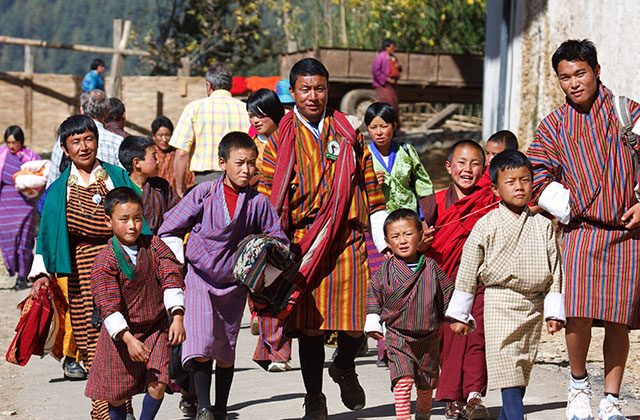
Bhutan has three major ethnic groups. This includes Ngalops – western Bhutanese, Sharchops – eastern Bhutanese and Lhotshampas – southern Bhutanese.
Ngalops are the descendants of Tibetan immigrants who came to Bhutan as early as the 9th century. They are dominant in the northern, central and western parts of the country. It is the largest ethnic group and makes up about half of the population. Ngalops are often simply identified as Bhutanese and they speak Dzongkha, the national language.
Sharchops are the populations of mixed Tibetan, Southeast Asian and South Asian descent. It comprises most of the population of eastern Bhutan. It has long been the largest single ethnic group in the country. Most Sharchops speak Tshangla, a Tibeto-Burman language but fewer speak Olekha (Ole-language). They also speak the national language, Dzongkha.
Lhotsampas are a heterogeneous Bhutanese people of Nepalese descent. They occupy the southern belt migrated to Bhutan in the early 20th century from the neighboring regions across the border. Lhotsampas speak lhotsamkha and are Hindus by faith unlike the rest of the population who are mostly Buddhists.
Dzongkha is the national language with both written and spoken. Sharchop and Lhotsham are also largely spoken in the country. Besides, Bhutan has at least 16 local dialects spoken by different communities across the country. Scholars contend that these languages developed as communities settled in the river valleys. It was said that the movement was minimal because of the extremely mountainous terrain.
The rugged environment that compelled communities to be self-sufficient has also cultivated a strong sense of independence among the Bhutanese people. But they come together to help each other in labour-intensive tasks and track their progress. They make sure that their neighbors are not doing it alone. Working together can help in several ways in easing tensions and creating a sense of community.
Bhutan has several small remote communities that differ from the mainstream population. These include Doyaps in the south, Layaps in the north-west, Monpas of central Bhutan, and the nomads of Merak and Sakteng in eastern Bhutan.
Bhutan is an agrarian country with more than 60 percent of the population engaged in agriculture and livestock farming. The country has seen a shift from traditional subsistence farming to more economically lucrative commercial farming in the last few years. This was made possible due to the government’s focus on self-sufficiency.
Women play a major role in the development activities in the country. The law gives women and men equal important. They do not face any institutionalized form of discrimination. There is equal participation of women and men in decision-making. The participation of women in district and block development council is actively increasing. But women are not yet adequately represented at the higher levels of government and decision-making. Traditionally, marriages happen without much fanfare. The young people generally choose their partners. In recent years, it has become a trend to hold formal wedding celebrations. The divorced women are not ostracized by society and thus go for a second and third marriage. Grandparents play an important role in bringing up their grandchildren and passing on age-old values to the new generations.
The Bhutanese hold strong spiritual beliefs. They generally spend free time on auspicious days, visiting monasteries, chortens, holy places, and religious sites to offer prayers and butter lamps for universal harmony. The prayers are being held to pay tribute to the Buddhist teachers and legends who contributed to building the nation.
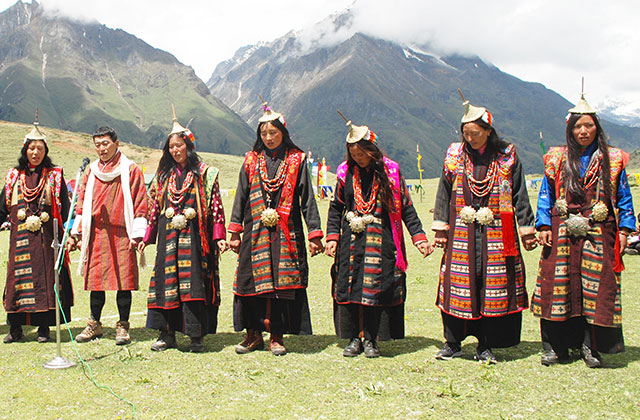
The distinct arts and crafts of Bhutan embody its ancient heritage. This was once part of a Himalayan Buddhist civilization that spanned deep into Central Asia. It contributes to economic growth as an additional source of income for skilled artisans across the country. It also continues to thrive the values and beliefs of an ancient Himalayan Buddhist society.
The arts and crafts can be seen in intricate textile weaves and the awe-inspiring centuries-old fortresses. These structures command hilltops to the finely crafted wooden bowls and baskets. The colours used are natural, blending into the rugged mountain surroundings. The shades represent religious undertones with deep meaning and significance. The style can appear similar to Tibet for a lay visitor, but it has developed a distinctive touch over the centuries. That was influenced by culture, religion and the environment to emerge uniquely Bhutanese.
The 13 traditional arts and crafts (Zorig Chusum) include papermaking, woodwork, sculpting, bamboo work, weaving, painting, carving, stonework, casting, tailoring and embroidery, woodturning, black-smithy and ornament making. It continues to thrive today as in the past. The government also established two institutes to preserve and promote the 13 traditional arts and crafts.
Different regions in the country are well known for specific arts and crafts. The central region in Zhemgang district stands for its unique bamboo weaves such as Bangchu. This is the olden days, served as a tight-fitting portable lunch box. Today, its usage has grown to serve as a bamboo bowl to display or hold items from pens to chocolates.
The eastern part of Bhutan encompasses the skills of woodturning and paper making. This was once a huge trading center for merchants of Bhutan, Tibet, and India. Papermaking and wood carving in Trashiyangtse are very famous. The people sell lacquered wood items and polished wood products made of Rhododendron wood. The handicraft store sits right at the town center offers a good variety of butter lamps, wooden bowls, brass items, and other souvenir options.
Likewise, the central region in Bumthang is famous for its yathra. It is a thick hand woven woolen textile with intricate designs that have been a unique specialty of weavers in Chummey village for generations. It is also a tradition that has been kept alive by the women weavers for their livelihood. The women weave throughout the year as it is their main source of cash income.
The village of Khoma in Lhuentse is home of the pure silk Kishuthara (silk woven) weave. It is an extremely intricate patterned silk textile woven by the women of Khoma village and thus popularly known for producing Kishuthara. Every Bhutanese woman hopes to own to be worn during special occasions. Wearing a Kishuthara in Bhutanese society makes a statement of status and etiquette. The costly Kishuthara takes almost a year to complete due to its complicated patterns and designs. It costs based on the complication of the pattern, design and the quality of brocades being used.
Besides, Thangkha painting and statue making are specialized divine skills in the country. The Bhutanese society is deeply rooted in spiritual beliefs and it continues to be in high demand across the country. Not limited to these, there are many arts and crafts in the country that holds the identity of tradition and culture.

Bhutan experiences all the four seasons – spring, summer, autumn, and winter. But weather conditions can change dramatically within a short time. This is because of the mountainous terrain and variation in altitude. It moves from a valley to a mountain pass and then to the foothills, bordering the Indian plains.
Bhutan’s altitude varies from about 300-meters above sea level and goes as high as 7,000-meters above sea level. The highest altitude is at the Himalayan peaks form a natural boundary. There are three broad climatic zones within this altitudinal range. These are the subtropical south, temperate zone in the central region and alpine regions in the north.
Winter in Bhutan is generally dry and cold in the central region. The higher altitudes receive snowfall and some remain covered with snow throughout the year. The southern part receives moderate weather conditions in winter. Summer is characterised by heavy monsoon rains. This often blocks highways but most of the roads are pliable during the monsoon season. In the southern foothills, the places are hot and humid in summer.
Spring and autumn are the best seasons to visit Bhutan. It is the time when major religious festivals take place. The weather makes it a good time for trekking and hiking across the country. Tourists can experience the mountains' lifestyle around the glacial lakes. Spring is generally filled with a profusion of colours. It sees blossoming of wildflowers and the hillsides turn green. The forests become a magical sight with about 50 species of rhododendrons and other exotic species in full bloom. The spring season falls between March-end until early June.
Another good time of the year in Bhutan is autumn. It begins in September and lasts until early November. Thimphu Tshechu (annual festival) generally falls in autumn when the countryside is a shade of gold with the ripening paddy harvest. Many of the annual festivals in other districts also take place in autumn.

The economy of Bhutan is based on agriculture and forestry. It provides the main livelihood for more than 60 percent of the population. Its rugged mountains that dominate the terrain challenged in the building of roads and made other infrastructure expensive. The development activities are dependent on donor funding from multilateral development organizations.
Bhutan has made huge strides in improving the lives of the people by investing in health and education. This was made since it embarked on planned development in the 1960s to modernize the economy. Each economic initiative takes into account the government’s desire. This is to protect the environment and cultural traditions of the country.
Hydropower is the engine of economic growth in Bhutan. It has invested heavily in harnessing hydropower potential to generate much-needed revenue for social welfare programs and reduce dependence on donors. Bhutan exports its surplus generation to the southern neighbour, India. Several hydropower projects are under construction and the target is to export at least 5,000-MW of power to India by 2020.
Harnessing clean and renewable hydropower energy has led to industrial development along the southern belt, close to the Indian border and markets. This also helped to electrify the interior districts and far-flung villages. The country harnesses its potential of around 23,000-MW of clean and green renewable energy.
Besides hydropower, the tourism industry earns additional revenue for the government and rural communities. It is on the top of hard currency earner for the government. It provides employment opportunities. Tourism accounts for nearly 40 percent of all employment, providing livelihoods for hundreds of thousands.
This is in line with the country’s overall development philosophy of Gross National Happiness. It gives paramount importance to the protection of the natural environment and sustainable economic development. The Gross National Happiness philosophy attempts to strike a balance between material and spiritual needs. This helps to create the conditions where citizens can pursue happiness. Economic development must not come at the cost of the natural environment and culture.
Unemployment is the greatest challenge to the nation’s development. Bhutan’s unemployment rate stands at 3.4 percent as per the Labour Force Survey Report of 2018. The overall youth unemployment rate is estimated at 15.7 percent. The youth unemployment challenge was bigger for females than their male counterparts. There was a high rate of joblessness and unemployment in urban areas as compared to rural areas. But unemployment is expected to address more seriously. Besides, poverty and rural-urban migration are beginning to emerge.
The country has witnessed a remarkable economic transformation from traditional to the modern economy. However, it realized there needs to do a better job of diversifying the economy. The government, therefore, focuses on promoting an inclusive, sustainable and equitable economy that contributes to Gross National Happiness. Helping diversify the economy drives progress by providing better opportunities and ways of life for citizens.
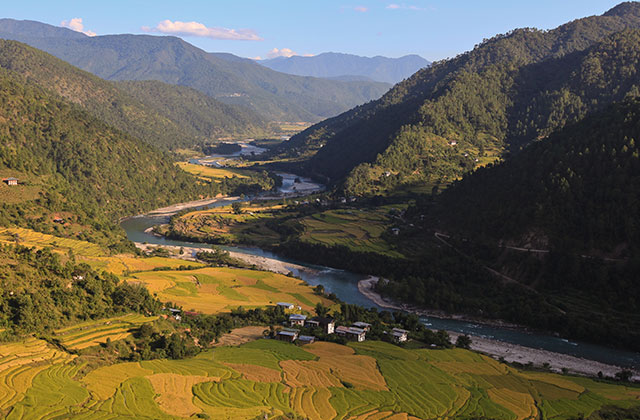
Bhutan is perhaps one of the few countries in the world that have always prized its natural environment and protected areas. The fundamental relationship between humans and nature has been practicing long before the world started making a clamour over its widespread exploitation.
The priority to preserve the natural environment is enshrined in Bhutan’s development philosophy of Gross National Happiness. One of the four pillars is the preservation of the environment. This commitment has resulted to enjoy with clean fresh mountain air and crystal clear mountain streams.
The Constitution of the Kingdom of Bhutan explicitly states that the country must maintain a forest cover of a minimum of 60 percent for all times to come. Therefore, more than 70 percent of the country is covered by forests within which thrive an astounding diversity of flora and fauna, and untouched ecosystems. The dense untouched forests are home to an amazing variety of birds, plants, and animals.
More than 26 percent of the country is made up of national parks and protected areas that are linked through biological corridors to allow the undisturbed movement of wild animals from one area to another. This is the reason why Bhutan has been identified as one of the world’s biodiversity hotspots.
Bhutan’s commitment to preserving the natural environment is so strong that it often comes in conflict with the development plans such as building roads and infrastructure. This respect comes from the Buddhist understanding of the interdependence between humans and nature. Mountain climbing is not allowed because Bhutanese believe that it is the abode of gods. It also believes that lakes and water bodies should not be polluted where deities reside in them.
Besides, Bhutan declared that it would remain a carbon-neutral country at the 15th United Nations Climate Summit in Copenhagen, Denmark in 2009. Today, Bhutan received global attention for its commitment to remain a carbon-neutral country for all times to come.
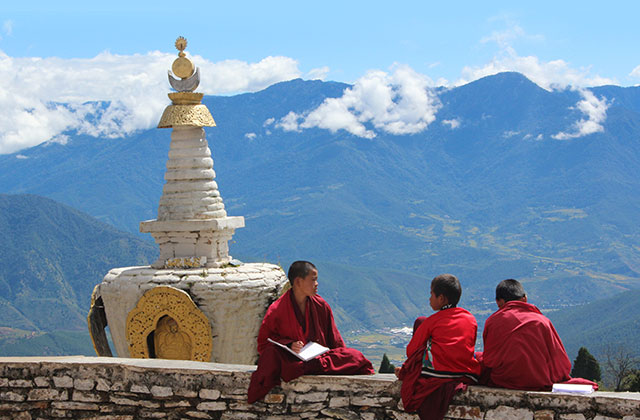
The official religion in Bhutan is Vajrayana Buddhism. It is a Buddhist country by the constitution and thus plays a vital role in the country. Buddhism is the cultural heritage of Bhutan. This is reflected in hundreds of thousands of monasteries, temples, stupas and prayer flags.
Bhutan has been home to many sages and saints over the centuries since Guru Rinpochhe brought Buddhism to Bhutan in the 8th century. Kuenkhen Longchen Ramjam, Phajo Drukgom Zhigpo, Tortoen Pema Lingpa, Drukpa Kuenley, Zhabdrung Ngawang Namgyal and Gyalse Tenzin Rabgye are some of the key figures of Bhutanese Buddhism. Drukpa Kagyu, the school of Tantric Mahayana Buddhism, is the official state religion. Although it is similar to Tibetan Buddhism, it has its own set of unique beliefs and practices.
More than 70 percent of Bhutanese follow either the Drukpa Kagyu lineage of the Nyingma school of Tibetan Buddhism. According to the Constitution, Drukpa Kagyu as the state religion of Bhutan and Buddhism is the country’s spiritual heritage. Religious institutions and personalities bear the responsibility of promoting the country’s Buddhist heritage. Besides, the country’s monk population about 8,000 is higher than the standing army.
The southern Bhutanese – Lhotshampa communities follow Hinduism. Christians are present in small numbers and generally among the Lhotsham population. It has numerous Hindu temples and a Patshala catering to the study of Sanskrit. Hindu religion has many common saints and divinities with Vajrayana Buddhism – the school of religion prevalent in Bhutan. The main protective deity of the country, Yeshey Gonpo or Mahakala, is a Tantric Buddhist form of Hindu God Shiva and often appears in the form of a raven.
The Constitution guarantees religious freedom and Bhutanese citizens can follow any faith they want proselytization is not permitted. The construction of the first Hindu temple in the capital, Thimphu, began toward the end of 2012 and completed in 2019. It is funded by the government.
Religion and politics are separate, according to the Constitution. The religious personalities and people registered with religious institutions do not have the right to vote. This is to ensure that religion is above politics.
Bhutan has a religious organizations Act (2007), which aims to protect the country’s spiritual heritage. All religious organizations are required to register with the regulatory authority created by the Act. The authority has the responsibility of managing and regulating religious organizations. The authority must promote the values of peace, non -violence, tolerance, and compassion. Religious organizations are required to be transparent and respect indigenous customs, identity, culture, and values.
Religious Institutions continue to play an important role in Bhutan. Besides the formal monastic structure supported by the state, the monk body also includes monks and nuns who are not part of state-sponsored institutions. Monks continue to play an important role in the daily lives of people. They perform religious ceremonies and preserve and promote traditional scholarships. Monastic institutions offer an alternative and traditional approach to education.
